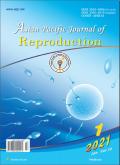Excess iodine supplementation aggravates the toxic effects induced by perchlorate on the male reproductive system in rats
IF 0.6
Q4 REPRODUCTIVE BIOLOGY
引用次数: 1
Abstract
Objective: To investigate the toxicity of excess iodine and perchlorate co-exposure on male reproductive system in rats. Methods: Eighteen male Wistar albino rats were divided into three groups. Group 1 received no treatment and served as the control group. Group 2 received perchlorate alone (130 mg/kg body weight), and group 3 received perchlorate (130 mg/kg body weight) plus excess iodine (0.7 mg potassium iodine/100 g body weight) for 45 days. Urinary perchlorate and iodine excretion pattern, testicular iodine concentration, serum testosterone levels, epididymal sperm count, key enzymes of steroidogenic pathway, reactive oxygen and nitrogen species including total antioxidant profiles in testis with electron microscopic ultrastructure analysis of spermatozoa were evaluated. Results: Co-exposure of perchlorate and excess iodine reduced their excretion pattern, reflecting accumulation with reactive oxygen species generation. It was accompanied by higher lipid peroxidation level with imbalance in the pro-/antioxidant status, inhibiting the activities of Δ5 3 β-hydroxysteroid dehydrogenase (HSD) and 17 β-HSD rate limiting enzyme activities, and causing reduced synthesis of testosterone, parallel to reduction in testicular and accessory sex organs weight, epididymal sperm-count with deformed ultrastructure of sperm. Perchlorate alone was not a reproductive toxicant; however, in combination with excess-iodine, acute effects were noticed, resulting in a severe deterioration of testicular and spermatozoal structure and function. Conclusions: This study provides a novel insight on the augmentation of the relatively moderate repro-toxic effects of perchlorate to a more severe form in presence of excess iodine on male reproductive physiology, which justifies further investigations.过量补碘加重高氯酸盐对大鼠雄性生殖系统的毒性作用
目的:探讨过量碘和高氯酸盐共同暴露对大鼠雄性生殖系统的毒性。方法:将18只雄性Wistar白化大鼠分为三组。第1组不接受任何治疗,作为对照组。第2组接受高氯酸盐单独治疗(130 mg/kg体重),第3组接受高碘酸盐(130 mg/kg重量)加过量碘(0.7 mg碘化钾/100 g体重)治疗45天。通过精子电镜超微结构分析,评价了尿高氯酸盐和碘排泄模式、睾丸碘浓度、血清睾酮水平、附睾精子计数、甾体生成途径关键酶、活性氧和活性氮物种(包括总抗氧化物)在睾丸中的分布。结果:高氯酸盐和过量碘的共同暴露降低了它们的排泄模式,反映了活性氧生成的积累。伴随着较高的脂质过氧化水平和促/抗氧化状态的失衡,抑制Δ5 3β-羟基类固醇脱氢酶(HSD)和17β-HSD限速酶的活性,并导致睾酮合成减少,同时睾丸和副性器官重量、附睾精子数减少,精子超微结构变形。高氯酸盐本身并不是一种生殖毒性物质;然而,与过量碘联合使用会引起急性影响,导致睾丸和精子结构和功能严重恶化。结论:这项研究提供了一个新的见解,即在过量碘存在的情况下,高氯酸盐的相对中等的再毒性作用会增强到更严重的形式,这有助于进一步的研究。
本文章由计算机程序翻译,如有差异,请以英文原文为准。
求助全文
约1分钟内获得全文
求助全文
来源期刊

Asian Pacific Journal of Reproduction
Veterinary-Veterinary (all)
CiteScore
1.70
自引率
0.00%
发文量
588
审稿时长
9 weeks
期刊介绍:
The journal will cover technical and clinical studies related to health, ethical and social issues in field of Gynecology and Obstetrics. Articles with clinical interest and implications will be given preference.
 求助内容:
求助内容: 应助结果提醒方式:
应助结果提醒方式:


